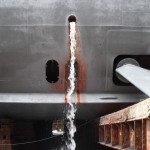Dry Docks – What to expect as a Deck Officer – Hull Painting
Thursday, April 16th, 2015 at 06:00 | by Alistair BaillieThis is the second post in a series covering what you can expect as a Deck Officer on passenger ships during dry docking, if you’ve not already done so, I suggest starting at the beginning!
Disclaimer: I am not an expert on dry docking, this is intended purely as an informal guide of what to expect, if you want more details on any of the below, I suggest Googling key terms.
Hull Painting
As I hope you’re aware the type of paint coating used on the hull, as well as affecting the look of the ship can more importantly have a major effect on the fuel efficiency and top speed of the vessel.
The painting of the hull is surprisingly complicated, the coatings that are to be applied usually have fairly limited temperature and humidity ranges that they can be put on to the hull, in addition to requiring specific base coats or surface preparation to be in place before they can be applied which is usually the main reason why your hull would be blasted to a particular finishing level.
It’s unlikely that someone on your ship or even at your company will have just ordered X litres of paint normally a discussion takes place between shore management and your paint coating supplier, some of the biggest ones are Jotun, Hempel and International who will be awarded a contract to supply the paint coatings for the hull. As you can imagine this easily costs a few hundred thousand dollars with a large opportunity for claims to be made if it doesn’t do as advertised. For this reason, usually the paint supplier has one of their “Paint Superintendents” attend the dry dock.
The Paint Superintendents will spend a few hours each day wondering around the hull taking and recording hull temperature, humidity and air temperature readings while supervising the application of the various coatings. It’s important to note that they are not necessarily working for the ship / your company so normally you will have to take your own readings.
“Watching paint dry” isn’t very exciting but if you have an opportunity to do so it’s worth spending some time wondering around with these guys as they’re usually always happy to explain what they’re doing & why it has to be done.
They’ve also got lots of experience of dry docks – spending most of their working lives in them – so if you strike up a good relationship with them, they’ll usually help you out by pointing things out that might not be quite right which is great if it’s your first dry dock and they often speak the local language which can be a life saver when your trying to communicate with some of the dock supervisors.
As a Deck Officer if you’re supervising the painting it’s a good idea to take photos after each coating is applied as well as recording the start time / end time of each coating. It’s usually also a good idea to record the air temperature & humidity at least every hour and start / end time of any precipitation until the entire process has been completed as you can guarantee someone will ask you for it later.
Remember and check in the various inlets and particularly around the bilge keel to ensure the coatings been applied fully, it’s also normal for small sections under the blocks to be missed – unless your company is paying for the blocks to be moved to allow full painting to occur. If you’re running the ships engines for electrical power then despite the best efforts of the shipyard to fit pipes there will be a little cooling water running down the hull below the outlets making painting of those parts impossible.
To be continued…

